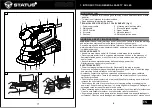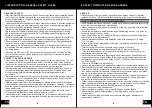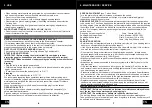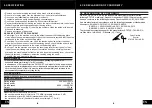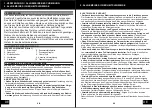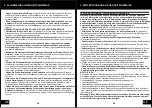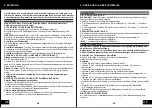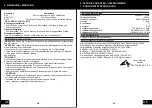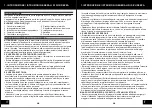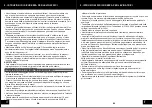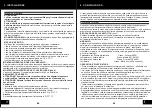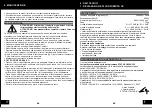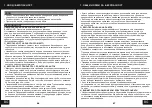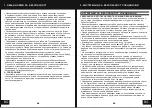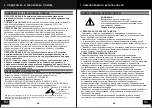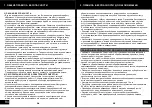
4
EN
1. INTRODUCTION / GENERAL SAFETY RULES
PERSONAL SAFETY
•
Stay alert, watch what you are doing and use common sense when operating a power
tool. Do not use a power tool while you are tired or under the influence of drugs,
alcohol or medication. A moment of inattention while operating power tools may result
in serious personal injury.
•
Use personal protective equipment. Always wear eye protection. Protective equipment
such as dust mask, non-skid safety shoes, hard hat, or hearing protection used for
appropriate conditions will reduce personal injuries.
•
Prevent unintentional starting. Ensure the switch is in the off-position before connec-
ting to power source and/or battery pack, picking up or carrying the tool. Carrying
power tools with your finger on the switch or energising power tools that have the
switch on invites accidents.
•
Remove any adjusting key or wrench before turning the power tool on. A wrench or a
key left attached to a rotating part of the power tool may result in personal injury.
•
Do not overreach. Keep proper footing and balance at all times. This enables better
control of the power tool in unexpected situations.
•
Dress properly. Do not wear loose clothing or jewelry. Keep your hair, clothing and
gloves away from moving parts. Loose clothes, jewelry or long hair can be caught
in moving parts.
•
If devices are provided for the connection of dust extraction and collection facilities,
ensure these are connected and properly used. Use of dust collection can reduce
dust-related hazards.
POWER TOOL USE AND CARE
•
Do not force the power tool. Use the correct power tool for your application. The cor-
rect power tool will do the job better and safer at the rate for which it was designed.
•
Do not use the power tool if the switch does not turn it on and off. Any power tool that
cannot be controlled with the switch is dangerous and must be repaired.
•
Disconnect the plug from the power source and/or the battery pack from the power
tool before making any adjustments, changing accessories, or storing power tools.
Such preventive safety measures reduce the risk of starting the power tool
accidentally.
•
Store idle power tools out of the reach of children and do not allow persons unfamiliar
with the power tool or these instructions to operate the power tool. Power tools are
dangerous in the hands of untrained users.
•
Maintain power tools. Check for misalignment or binding of moving parts, breakage
of parts and any other condition that may affect the power tool's operation. If damaged,
have the power tool repaired before use. Many accidents are caused by poorly main-
tained power tools.
•
Keep cutting tools sharp and clean. Properly maintained cutting tools with sharp
cutting edges are less likely to bind and are easier to control.
2. SAFETY INSTRUCTIONS FOR SANDERS
•
Use the power tool, accessories and tool bits etc., in accordance with these instruc-
tions, taking into account the working conditions and the work to be performed.
SERVICE
•
Have your power tool serviced by a qualified repair person using only identical
replacement parts. This will ensure that the safety of the power tool is maintained.
SAFETY INSTRUCTIONS FOR SANDERS
•
Avoid damage that can be caused by screws, nails and other elements in your work-
piece; remove them before you start working
•
Always keep the cord away from moving parts of the tool; direct the cord to the rear,
away from the tool.
•
Secure the workpiece (a workpiece clamped with clamping devices or in a vice is
held more securely than by hand).
•
When you put away the tool, switch off the motor and ensure that all moving parts
have come to a complete standstill.
•
Use completely unrolled and safe extension cords with a capacity of 16 Amps
(U.K. 13 Amps).
•
In case of electrical or mechanical malfunction, immediately switch off the tool and
disconnect the plug.
•
This tool should not be used by people under the age of 16 years
•
The noise level when working can exceed 85 dB(A); wear ear protection
•
If the cord is damaged or cut through while working, do
not touch the cord, but
immediately disconnect the plug.
•
Never use the tool when cord is damaged; have it replaced by a qualified person
• Always check that the supply voltage is the same as the voltage indicated on the
nameplate of the tool (tools with a rating of 230V or 240V can also be connected
to a 220V supply).
•
This tool is not suitable for wet sanding
•
Do not work materials containing asbestos (asbestos is considered carcinogenic).
•
Dust from material such as paint containing lead, some wood species, minerals and
metal may be harmful (contact with or inhalation of the dust may cause allergic reac-
tions and/or respiratory diseases to the operator or bystanders); wear a dust mask
and work with a dust extraction device when connectable.
•
Certain kinds of dust are classified as carcinogenic (such as oak and beech dust)
especially in conjunction with additives for wood conditioning; wear a dust mask
and work with a dust extraction device when connectable.
•
Follow the dust-related national requirements for the materials you want to work with.
5
EN
•
When sanding metal, sparks are generated; do not use dustbox/vacuum cleaner
and keep other persons and combustible material from work area.
•
Do not touch the moving sanding sheet.
•
Do not continue to use worn, torn or heavily clogged sanding sheets.
•
Wear protective gloves, safety glasses, close-ftting clothes and hair protection
(for long hair).
•
Always disconnect plug from power source before making any adjustment or
changing any accessory.


